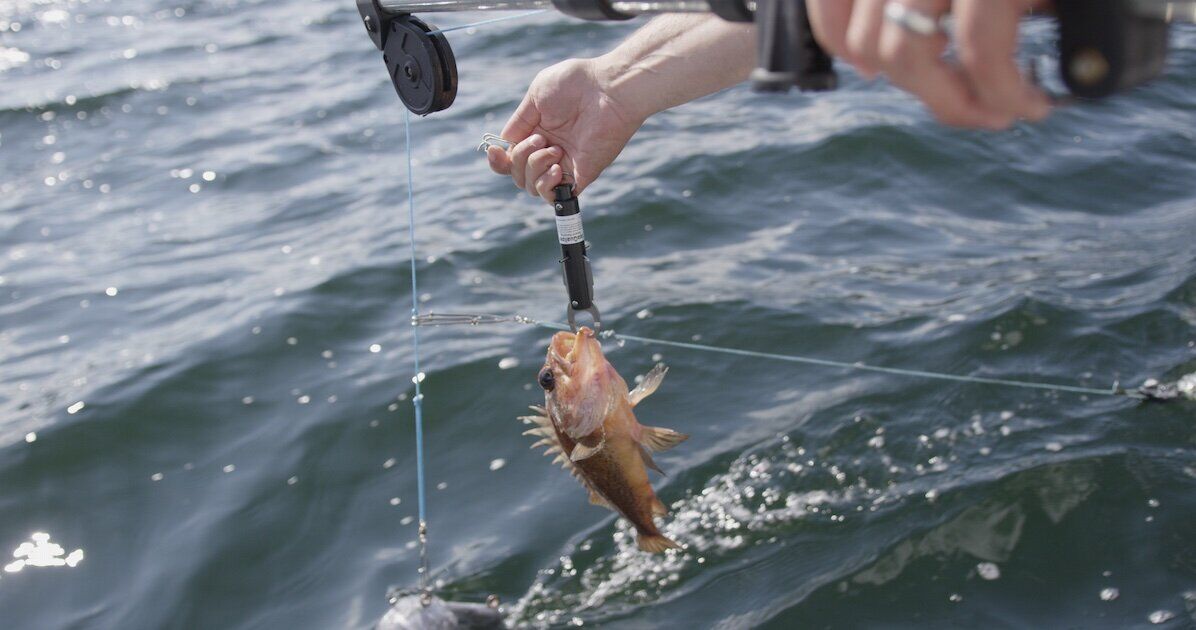
There are 109 species of rockfish in the Pacific region, and British Columbia is home to many. With some species living up to 115 years, rockfish are slow-growing, late-maturing, and territorial, making them especially sensitive to fishing pressure and bycatch.
Pacific Rockfish Conservation Areas (RCA’s) were established in 2007 to protect and rebuild a portion of in- shore rockfish populations. In recent years, it was determined that yelloweye and boccaccio rockfish on BC’s outer coast also need help to rebuild stocks.
Adding to the effects of fishing pressure, rockfish suffer from barotrauma (much like human divers suffer from “the bends”) and expand with gasses when they are brought to the surface. Rockfish have closed swim bladders and cannot adjust to rapid pressure changes. Without help, a rockfish that comes to the surface will not survive. But, with minimal handling, lowering it back to near the depth of capture using a descending device significantly improves the likelihood of survival.
“What is barotrauma” – Fisheries and Oceans Canada
After several years and analysis by DFO, descending devices are now mandatory when recreational anglers release rockfish. Using a descending device, the recreational fishery can help to reduce rockfish mortalities considerably. Studies in California and Washington have shown that descending devices reduce rockfish bycatch mortalities by as much as 80%. In California, use of the devices has allowed regulations for harvest of other species that were known to cause bycatch of rockfish to be relaxed and changed. The requirement to use a descending device is a positive step to structure recreational fisheries in a way that minimizes our impact on these fish.
2019 being the first year of mandatory use in BC, a combined education and awareness campaign was important to properly get the word out and to make anglers aware of this new requirement. Tackle retailers have devices available. There are options ranging from an inverted hook to a pressure-activated device. All are simple to use and very effective, changing mortality of a rockfish that comes to the surface from 100% to somewhere around 20%. The devices have been used successfully in BC for several years now, and the new requirement will help to protect opportunity for the public fishery on other species where rockfish bycatch is a possibility.
How You Can Help the Rockfish Population
Protecting Rockfish download
Avoid
Protect rockfish by avoiding their habitat when fishing for other species.
Identify
Learn how to accurately identify rockfish, particularly yelloweye rockfish, which are vibrant orange to red in colour with bright yellow eyes and two white to light stripes on the middle of the body that fade with age. They can grow up to 91 cm long and 11.3 kg.
Release
Rockfish can’t adjust to rapid pressure changes when brought to the surface. Handle as little as possible, (less than two minutes), watch out for the mildly poisonous spines, and use a descending device to quickly re-submerge the catch to near depth of capture. Move to another fishing location to avoid catching more.
Report
Catch reporting, whether through Fisheries and Oceans Canada’s creel survey or the internet, is mandatory. Be sure to self-record what you catch and what you release and prepare to share your reports. Your catch information is a critical factor for ensuring accurate stock assessment of all recreational harvested species.
Types of Descending Devices
Common types of descending devices include a simple, inverted barbless hook, a spring-loaded clamp, and a pressure-release clamp. Of the different devices available, the most effective and simplest to use is a depth pressure activated release device, the Seaqualizer, pictured. Automatically opening at preset depth, the motion of the boat or the actions of the rockfish as it descends will not prematurely release the fish.
CHP Seaqualizer
How to Use a Descending Device
Simply have your device at the ready if you are fishing in a location or depth where it is possible you may encounter a rockfish. Handle the fish as little as possible, return it to the water attached to the device, and slowly lower using either a weighted line or a downrigger to as close to the depth of capture as possible.
Photo Courtesy of SFI
This article appeared in Island Fisherman magazine. Never miss another issue—subscribe today!
Visit the Store
$34.99
$34.99
Featured Catch
Joel Unickow halibut (Photo: Rob Frawley Lucky Strike Sportfishing Tofino)



